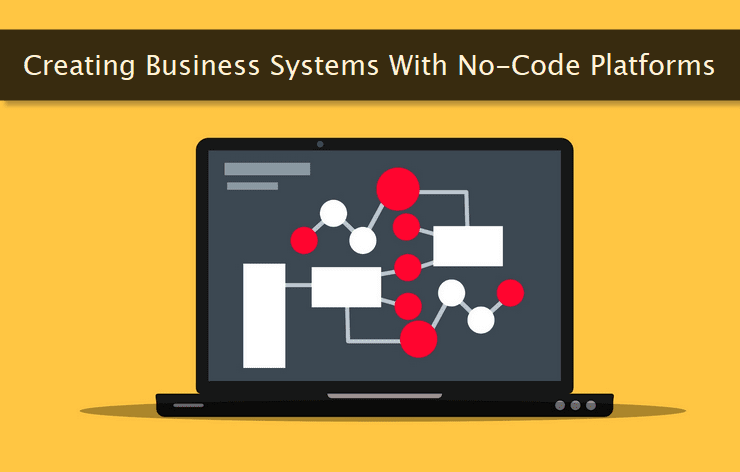For businesses of all sizes, expenses can quickly add up, and finding ways to save time and money are essential for survival in today’s competitive market. With the advancement of no-code platforms, businesses can save time and money by developing applications faster with simplified coding processes that allow you to make the most out of your resources. In this blog post, we’ll explore how these no-code platforms work and discuss the different ways they can be used to increase efficiency for marketers and technical users alike.

Introducing No-Code Platforms - What Are They and How Can They Help Your Business
No-code platforms provide a new way to build applications and automate business processes. By leveraging ready-made building blocks, no-code solutions enable any user to create complex applications quickly, with no coding skills required. These platforms come with many advantages, making it faster and cheaper to bring an idea to market.
From process automation solutions to full-fledged web and mobile apps – the possibilities are endless. Whether you're looking for personal or business use cases, no-code is the future of app creation that can truly help your business succeed in today's digital world.
Benefits of No-Code Platforms Over Coding in Traditional Languages
No-code development platforms are providing technology teams with an innovative way to build applications and avoid the traditional pitfalls of coding in languages such as Java or Javascript.
Low-code and no-code platforms provide many advantages including quicker time to market, easier maintenance, improved team collaboration between engineers, business analysts, and subject matter experts, and a more intuitive interface for non-coders.
Because of their flexibility and easy adaptability, no-code development platforms have become a go-to choice for cost-effective application development that is secure, compliant, and scalable. All these advantages make no-code platforms an attractive option overwriting code in traditional programming languages.
Leveraging Automation to Increase Efficiency and Cut Costs
Leveraging automation offers a great opportunity for businesses to increase efficiency and reduce costs. Automation can take the form of integrated software for managing complex processes, robotic process automation (RPA) for tasks requiring dexterity or cognitive ability, or artificial intelligence (AI) technologies that help inform decision-making.
By automating mundane, repetitive tasks, organizations can free up valuable human resources to focus on more creative and demanding initiatives.
Furthermore, by eliminating manual errors that are prone to occur with manual labor, companies can drastically reduce wasted time and improve accuracy in their operations.
Automated solutions also hold the potential to provide significant cost savings due to improved productivity from a lower number of employees and/or machines needed to complete a given task. Automation offers a great way to improve business performance while cutting costs toward meeting strategic goals set by an organization's leadership.
Tips for Choosing the Right No-Code Platform
Choosing the right no-code platform is critical for success when it comes to projects that require automation and scale. When evaluating a platform, consider key criteria such as scalability and integration options. Ensure that any necessary third-party integrations will be available, whether you need an e-commerce integration or something more custom.
Additionally, review the security options that come with the platform and understand how data is stored and secured. Finally, do your research on customer support, as this can be essential when dealing with problems that may arise during code implementation or for questions about how to use the platform.
Being prepared and taking the time to evaluate all these factors can make all the difference in finding a no-code platform tailored to your project's unique needs.
Setting Up a No-Code Project - Step-by-Step Guide
Step 1: Define your project goals and requirements. Determine what you want to achieve with your no-code project and what features you need.
Step 2: Choose the right no-code platform for your project. Research different no-code platforms and choose one that fits your requirements and budget.
Step 3: Plan your project structure and user flow. Create a wireframe or prototype of your project to visualize its structure and user flow.
Step 4: Start building your project using the chosen no-code platform. Use the platform's drag-and-drop interface to create pages, forms, workflows, and other components of your project.
Step 5: Test and iterate on your project. Test each component of your project thoroughly, gather feedback from users or stakeholders, and make improvements as needed.
Step 6: Launch your project. Once you are satisfied with the quality of your project, launch it to the public or intended audience.
No-code platforms have made it easier than ever for businesses and individuals to create custom applications without any coding knowledge or experience.
By following this step-by-step guide, you can successfully set up a no-code project that meets your specific needs and achieves your desired outcomes. With a little planning, creativity, and persistence, anyone can leverage the power of no-code tools to bring their ideas to life.
Conclusion
To conclude, no-code platforms have come a long way in the past few years, offering businesses meaningful and sustainable solutions to their development needs. With near-instant setup and easy-to-learn user interfaces, your business can take advantage of these platforms to gain an advantage over competitors who may still be relying on traditional coding languages.
Automation is also readily available with these platforms, allowing you to complete projects faster than ever before while cutting out waste. No-code development does however come with its own set of pitfalls that must be avoided if your project is to succeed; but by following the tips outlined in this blog post such as choosing the right platform for your needs and planning ahead, you can ensure your project is successful from inception to completion.
So why not embrace technology and take advantage of no-code platforms today? Your business could be up and running in a matter of days - what are you waiting for?

